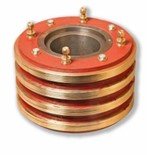Difference between slip rings and induction motors?
Slip Rings
Definition
A slip ring is an electromechanical device that allows the transmission of electrical power and signals from a stationary to a rotating structure. It is also known as a rotary electrical joint, collector, or electric swivel.
Function
The primary function of a slip ring is to ensure the continuous transfer of electrical signals, power, or data between stationary and rotating parts without causing twisting or tangling of wires. This is essential in systems that require continuous rotation and electrical connectivity.
Parts
-
- Rotating Rings: Conductive metal rings, usually made from materials such as brass, silver, or gold-plated materials, that rotate along with the shaft.
- Stationary Brushes: Conductive brushes, typically made of graphite or precious metals, that maintain contact with the rotating rings to allow the flow of electrical current.

Types and Working
-
- Through Bore Slip Rings: Designed with a hole in the center for shaft mounting, allowing cables and hoses to pass through.
- Capsule Slip Rings: Compact design suitable for low-current or signal applications, where space is limited.
- High Current Slip Rings: Built for high-power transmission, often with robust insulation and larger brushes and rings to handle increased electrical loads.

Working: As the shaft rotates, the brushes slide along the surface of the rings, maintaining electrical contact. This sliding contact allows electrical signals or power to be transferred between the stationary and rotating components without interruption.
Advantages
- Allows for continuous rotation without tangling of wires.
- Can transmit power and signals across rotating interfaces.
- Customizable to specific needs, including size, speed, and type of signal.
Disadvantages
- Physical wear over time due to the friction between brushes and rings.
- Potential for electrical noise and signal degradation.
- Requires regular maintenance to ensure reliable operation.
Uses
- Wind Turbines: Transfer power and signals from rotating blades to stationary components.
- Radar Antennas: Enable 360-degree rotation without interrupting electrical connections.
- Medical Equipment: Used in devices such as CT scanners for continuous data transfer during rotation.
- Industrial Machinery: Common in rotating tables, packaging machines, and automated systems that require continuous rotation.
Induction Motors
Definition
An induction motor is an electric motor that operates on alternating current (AC) and utilizes electromagnetic induction to produce mechanical motion. They are also known as asynchronous motors because the rotor does not rotate at the same speed as the magnetic field.
Function
Induction motors convert electrical energy into mechanical energy through the interaction of a rotating magnetic field created in the stator and the induced currents in the rotor. This interaction produces torque, causing the rotor to spin and drive mechanical loads.

Parts
- Stator: The stationary part of the motor, consisting of laminated iron cores and windings of insulated wire that create a magnetic field when AC is supplied.
- Rotor: The rotating part, which can be a squirrel cage or wound type. It is placed inside the stator and is induced by the magnetic field, creating an opposing magnetic field that causes rotation.
- Bearings: Support the rotor and reduce friction during rotation.
- Cooling Fan: Helps dissipate heat generated during motor operation, improving efficiency and lifespan.

Types and Working
- Single-Phase Induction Motors: Operate on a single-phase power supply and are commonly used in household appliances. They are not self-starting and require an additional mechanism, such as a capacitor, to initiate rotation.
- Three-Phase Induction Motors: Operate on a three-phase power supply, generating a rotating magnetic field that induces current in the rotor. These motors are self-starting and provide higher efficiency and power output, making them suitable for industrial applications.
Working: When AC power is applied to the stator windings, it creates a rotating magnetic field. This field induces a current in the rotor, which generates its magnetic field. The interaction between the stator and rotor fields produces torque, causing the rotor to turn and perform work.
Advantages
- Simple and robust construction with fewer moving parts.
- High reliability and low maintenance requirements.
- Cost-effective and efficient for a wide range of applications.
Disadvantages
- Speed is not easily controlled without additional components.
- Starting torque can be lower compared to other motor types.
- Efficiency decreases under light load conditions.
Uses
- Industrial Machinery: Widely used in pumps, compressors, conveyors, and fans due to their durability and efficiency.
- Household Appliances: Found in devices like washing machines, refrigerators, and air conditioners.
- Electric Vehicles: Used in the propulsion systems of electric cars and hybrid vehicles due to their high torque and efficiency.
- HVAC Systems: Commonly employed in heating, ventilation, and air conditioning systems for their reliability and low maintenance.

